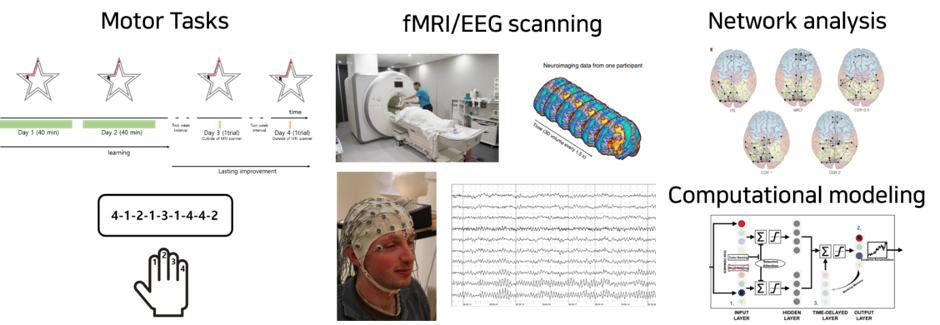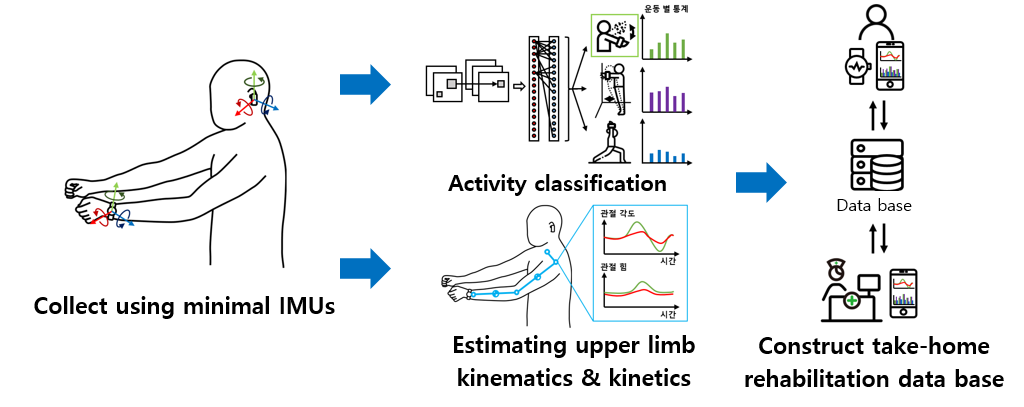Objectives
Neuroplasticity in cell-based stroke model
Understanding the effect of rehabilitation on neuroplasticity based on a cell
- based stroke model Measurement and analysis of electrophysiological signals during rehabilitation, and setting the electrical stimulation conditions for cells
- Platform design to stably apply electrical stimulation to cellular stroke model
- Investigation of the effects of electrical stimulation on neuroplasticity-related gene/protein of cells

Computational modeling to predict a rehabilitation outcome
We are developing a computational model to predict a patient’s rehabilitation outcomes based on brain motor network analysis.
- Motor learning network analysis
- Building a computational model for motor learning
- Constructing a rehabilitation predictor based on the motor learning model.

Brain-machine interface for high-effective rehabilitation
We are constructing a brain-machine interface system that reflects a patient’s motor intention to increase the patient’s active participation in rehabilitation sessions.
- Feature extraction for motor intention
- Building motor intention classifier using real-time EEG

Precision intention recognition – HD-sEMG based interface for Electromyography
Developing a robust motion intention recognition algorithm for the electrode position change, by stochastic signal decomposition
- Extraction of independent muscle unit signal
- Compensation algorithm for electrode position change
- Movement intention recognition system which is capable of distinguish external forces from users’ internal and forces by rehabilitation equipment

Compensating fatigue effect on muscle synergy
Developing a method to compensate fatigue effects during long-term exercise
- Examining muscle synergy difference due to muscle fatigue during long-term exercise of normal people
- Distinguish signal changes due to factors other than active muscles during long term exercise
- Examine the correlation between long-term muscle fatigue and muscle synergy by analyzing collected EMG signals

Upper limb muscle synergy model for patients with neurological disorders
Extraction, classification and analysis of upper limb muscle synergy model.
- Extraction of upper limb muscle synergy model from high-density EMG
- Study of correlation between characteristics of each patient’s synergy model and motor function
- Building a robot-based rehabilitation strategy based on change in upper limb synergy model

Take-home rehabilitation monitoring using wearable device
Developing home-based rehabilitation monitoring system using minimal IMUs
- Real-time upper-limb activities classification using machine learning
- Estimating upper limb kinematics and kinetics from minimal IMUs
- Extract take-home rehabilitation indicators from IMUs
- Construct data base of take-home rehabilitation

High DOF soft wearable device & control
Developing highly dexterous soft wearable glove capable of conducting challenging hand manipulation for patients with severe hand impairment.
- Designing soft wearable robotic glove with robust & flexible actuation
- BMI for recognizing dexterous finger/thumb movement intention
- Intelligent shared control of high DOF soft wearable glove

Custom intelligent soft wearable structure
Developing an intelligent soft wearable structure based on patient information to provide optimal assistive power and fit in daily life.
- Development of intelligent soft wearable structure based on patient joint stiffness measurement information
- Development and implementation of non-linear controller to assist user according to target stiffness

Sensory feedback and selective electrical stimulation system
Developing vibration and electrical stimulation system capable of propriception stimulation in appropriate areas and reducing stiffness and muscle tension.
- Development of a system that can simultaneously use muscle stimulation and nerve blocking
- Determine optimal electrode position and stimulation signal
- Integrating with the brain-robot interface and intention recognition system (EEG and large-area sEMG) to operate stroke patients

